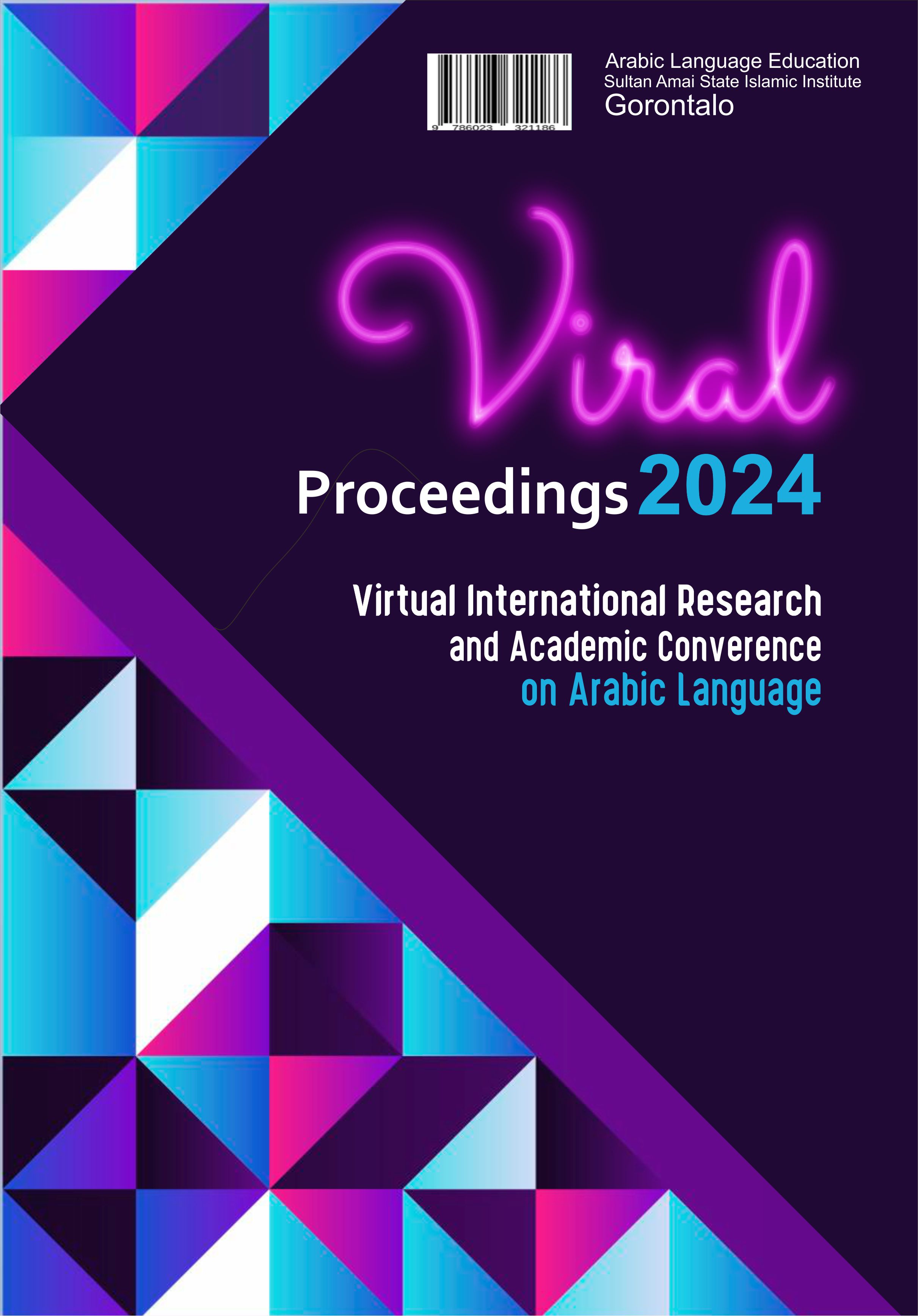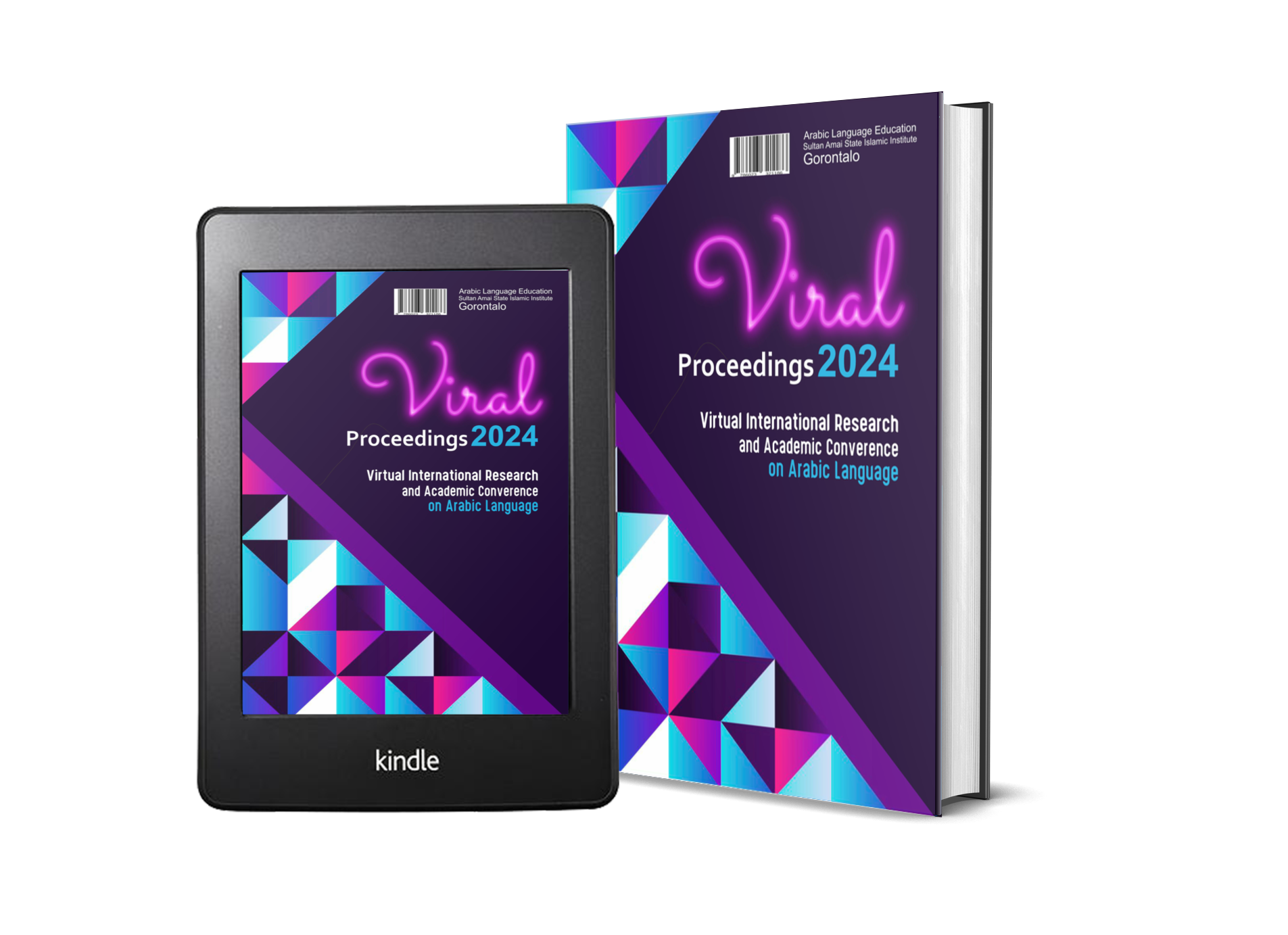The Implementation of the Cooperative Script Method to Enhance Arabic Vocabulary Mastery Among Grade XI Students at MAN Batudaa
Keywords:
Cooperative Script, Arabic vocabulary, Classroom Action Research, Language learning, Student engagementAbstract
This study investigates the effectiveness of the Cooperative Script method in enhancing Arabic vocabulary acquisition among Grade XI students at Madrasah Aliyah Negeri (MAN) Batudaa. Vocabulary mastery is a critical component of language learning, yet many students struggle with retention and application due to the limitations of traditional teaching approaches. To address this issue, the study applied a Classroom Action Research (CAR) design using Kemmis and McTaggart’s four-phase model: planning, action, observation, and reflection. The research was conducted over two instructional cycles during the first semester of the academic year and involved 22 students selected through purposive sampling. Data were collected using pre- and post-tests, observation sheets, and documentation. Descriptive statistical methods were employed to evaluate both individual and group-level progress in vocabulary mastery. Initial findings from the pre-test revealed an average score of 56.36, with only 36.36% of students reaching the minimum mastery threshold. After the implementation of the Cooperative Script method, significant improvements were observed. Observation scores increased from 70.83% in Cycle I to 95.83% in Cycle II, accompanied by greater student participation and more effective group collaboration. The results demonstrate that the Cooperative Script method positively impacts vocabulary acquisition by fostering active learning, peer interaction, and student engagement. These findings suggest that cooperative learning strategies can serve as practical and effective pedagogical tools in Arabic language instruction, particularly in classroom settings that aim to enhance both linguistic competence and learner confidence.
References
S. Y. Mei, S. Y. Ju, and A. B. Mohd, “Cooperative Learning Strategy in Teaching Arabic for Non Native Speakers,” Humanit. Today Proc., vol. 1, no. 2, pp. 112–120, 2022, doi: 10.26417/ejser.v11i2.p261-266.
A. Raden and N. Nurdin, “Dimensions of Application of Cooperative Script Method in Sociology Learning,” Sociol. Educ., vol. 2, no. 2, pp. 13–20, 2021, doi: 10.59098/socioedu.v2i2.485.
H. Li, B. Du, S. Tang, and J. Xu, “Effect of Cooperative Learning Strategies on Students’ Learning Motivation and Alienation,” Educ. Reform Dev., vol. 6, no. 7, pp. 236–243, 2024, doi: 10.26689/erd.v6i7.7772.
S. Nurhayati, “Model Cooperative Script Pada Pembelajaran Bahasa Inggris Aspek Berbicara: Sebuah Hipotesis,” Tatar Pas. J. Diklat Keagamaan, vol. 15, no. 1, pp. 20–32, 2021, doi: 10.38075/tp.v15i1.145.
H. Wijaya, I. Islahuddin, R. H. Gani, and N. Supratmi, “Pengaruh Metode Cooperative Script Terhadap Kemampuan Berbicara Pada Siswa Kelas IX SMP Negeri 1 Selong Tahun Pelajaran 2020/2021,” Alinea J. Bhs. Sastra Dan Pengajarannya, vol. 2, no. 1, pp. 120–130, 2022, doi: 10.58218/alinea.v2i1.181.
M. Juha and F. A. Milawasri, “UPAYA MENINGKATKAN KEMAMPUAN MEMBACA PEMAHAMAN SISWA KELAS VI SD DENGAN MODEL PEMBELAJARAN ≪em>COOPERATIVE SCRIPT</em,” J. Didact. Bhs. Indones., vol. 2, no. 1, p. 52, 2021, doi: 10.52333/didactique.v2i1.741.
S. Bećirović, V. Dubravac, and A. Brdarević‐Čeljo, “Cooperative Learning as a Pathway to Strengthening Motivation and Improving Achievement in an EFL Classroom,” Sage Open, vol. 12, no. 1, 2022, doi: 10.1177/21582440221078016.
A. Sopian, “Arabic Vocabulary Mastery Through Jaulah Arabiyyah Program in Improving Arabic Language Communication,” Int. J. Acad. Res. Bus. Soc. Sci., vol. 14, no. 2, 2024, doi: 10.6007/ijarbss/v14-i2/20665.
Z. Hasanah and A. S. Himami, “Model Pembelajaran Kooperatif Dalam Menumbuhkan Keaktifan Belajar Siswa,” Irsyaduna J. Stud. Kemahasiswaan, vol. 1, no. 1, pp. 1–13, 2021, doi: 10.54437/irsyaduna.v1i1.236.
A. Hudriati, S. Sulastri, and R. Rahmat, “Empowering English Language Learning: Unleashing the Potential of Cooperative Learning Model at SMKN 3 Takalar,” Elt Worldw. J. English Lang. Teach., vol. 10, no. 2, p. 463, 2023, doi: 10.26858/eltww.v10i2.53889.
O. Alabi and T. Bukola, “Introduction to Descriptive Statistics,” 2023, doi: 10.5772/intechopen.1002475.
G. Brooks, J. Clenton, and S. Fraser, “Exploring the Importance of Vocabulary for English as an Additional Language Learners’ Reading Comprehension,” Stud. Second Lang. Learn. Teach., vol. 11, no. 3, pp. 351–376, 2021, doi: 10.14746/ssllt.2021.11.3.3.
N. V Bhatti, O. A. Gorbacheva, N. А. Ivanova, Е. П. Савченко, and E. Y. Kharitonova, “Lexical Acquisition of Foreign Languages by Russian Native Speakers,” SHS Web Conf., vol. 127, p. 2015, 2021, doi: 10.1051/shsconf/202112702015.
K. Mitrajati, H. Zaini, and A. Holilulloh, “Acquisition of Arabic Vocabulary Through the Book Al-‘Arabiyyah Baina Yadaik (I) in Foreign Language Course Institutions,” Scaffolding J. Pendidik. Islam Dan Multikulturalisme, vol. 5, no. 2, pp. 1001–1014, 2023, doi: 10.37680/scaffolding.v5i2.3407.
B. Zou, X. Guan, Y. Shao, and P. Chen, “Supporting Speaking Practice by Social Network-Based Interaction in Artificial Intelligence (AI)-Assisted Language Learning,” Sustainability, vol. 15, no. 4, p. 2872, 2023, doi: 10.3390/su15042872.
F. L. Russa, V. D’Alessio, and A. Suadoni, “Designing a Corpus-Based Syllabus of Italian Collocations: Criteria, Methods and Procedures,” RRL, vol. 2023, no. 4, pp. 377–389, 2023, doi: 10.59277/rrl.2023.4.03.
T. D. L. Thach, “Teachers’ Perceptions of Comprehensible Input on English Vocabulary Acquisition,” Int. J. Lang. Instr., vol. 1, no. 1, pp. 120–131, 2022, doi: 10.54855/ijli.221110.
S. K. Yoke, S. A. Ahmad, R. M. Yunos, J. M. Amin, N. Sulaiman, and F. A. Majid, “Educator’s Readiness for 21st Century Education,” J. Eng. Appl. Sci., vol. 14, no. 9, pp. 10687–10692, 2020, doi: 10.36478/jeasci.2019.10687.10692.
S. Marmoah, R. Gestiardi, S. Sarwanto, C. Chumdari, and I. Maryani, “A Bibliometric Analysis of Collaboration Skills in Education (2019-2021),” J. Educ. Learn., vol. 16, no. 4, pp. 542–551, 2022, doi: 10.11591/edulearn.v16i4.20337.
T. Rugube, K. E. Mthethwa-Kunene, and C. Maphosa, “Rethinking Pedagogy: Interrogating Ways of Promoting Deeper Learning in Higher Education,” Eur. J. Interact. Multimed. Educ., vol. 3, no. 1, p. e02204, 2021, doi: 10.30935/ejimed/11439.
R. Wulandari, “Characteristics and Learning Models of the 21st Century,” Soc. Humanit. Educ. Stud. Conf. Ser., vol. 4, no. 3, p. 8, 2021, doi: 10.20961/shes.v4i3.49958.
D. A. Natuna, M. J. A. Putra, and A. Azhar, “TEACHERS’ PERFORMANCE IN ONLINE LEARNING DURING COVID-19 OUTBREAK: AN ANALYSIS BASED ON 21st CENTURY PROFICIENCY,” Int. J. Educ. Best Pract., vol. 5, no. 2, p. 197, 2021, doi: 10.31258/ijebp.v5n2.p197-210.
I. Prastyaningrum, N. Imansari, and U. N. Kholifah, “Analysis of Critical Thinking Skills and Collaboration of Electronic Engineering Education Students in Electrical Machinery Course,” Int. J. Indones. Educ. Teach., vol. 7, no. 1, pp. 114–120, 2023, doi: 10.24071/ijiet.v7i1.5091.
B. R. Putra, M. Samani, S. Suparji, S. Muslim, and S. Sunwinarti, “The 21st Century Capacity Development Strategy in the Subject of Motorcycle Chasis Maintenance at State Vocational High School (VHS)-1 of Gombong Kebumen,” 2020, doi: 10.4108/eai.3-8-2019.2290724.
W. K. S. Achmad and U. Utami, “The Synergy of the School Partnership Model in the Success of Educational Transformation,” pp. 1247–1253, 2023, doi: 10.2991/978-2-494069-35-0_150.
D. N. Saputra, “New Curriculum: The Concept of Freedom Learning in Music Learning in Department of Music Education,” pp. 20–26, 2020, doi: 10.31098/ictase.v1i1.15.
D. Muliyati, F. Prastiawan, and M. Mutoharoh, “Development of STEM Project-Based Learning Student Worksheet for Physics Learning on Renewable Energy Topic,” J. Phys. Conf. Ser., vol. 2596, no. 1, p. 12078, 2023, doi: 10.1088/1742-6596/2596/1/012078.
S. Siswanto, E. Trisnowati, F. Firmadani, S. Haryati, D. Aryanti, and H. N. Andrianto, “Workshop on Inquiry Learning Based Virtual Laboratory in Magelang for Preparing Natural Sciences Teacher in 21st Century: An Evaluation of Implementation’s Program,” Indones. J. Educ. Learn., vol. 3, no. 2, p. 367, 2020, doi: 10.31002/ijel.v3i2.3036.
M. Rosdiana, S. Sumarni, B. Siswanto, and W. Waluyo, “Implementation of 21st Century Learning Through Lesson Study,” 2020, doi: 10.2991/assehr.k.200323.041.
I. Nurulita, P. Ihtiari, D. P. F. Yubeleo, and K. Umi, “Optimizing 4C Skills Through Team Based Projects Using Product Oriented Modules for Electrical Engineering Education Students,” Sar J. - Sci. Res., pp. 87–94, 2022, doi: 10.18421/sar52-04.
K. Komalasari and D. N. Anggraini, “Civic Education for Development of Digital Citizenship in the Era of Industrial Revolution 4.0,” 2020, doi: 10.2991/assehr.k.200320.030.
Downloads
Published
Issue
Section
License
Copyright (c) 2024 Rukiah Tumaloto, Yuslin Kasan, Sitti Aisyah Chalik, Syifa Nurfadhila Sawal

This work is licensed under a Creative Commons Attribution-ShareAlike 4.0 International License.




